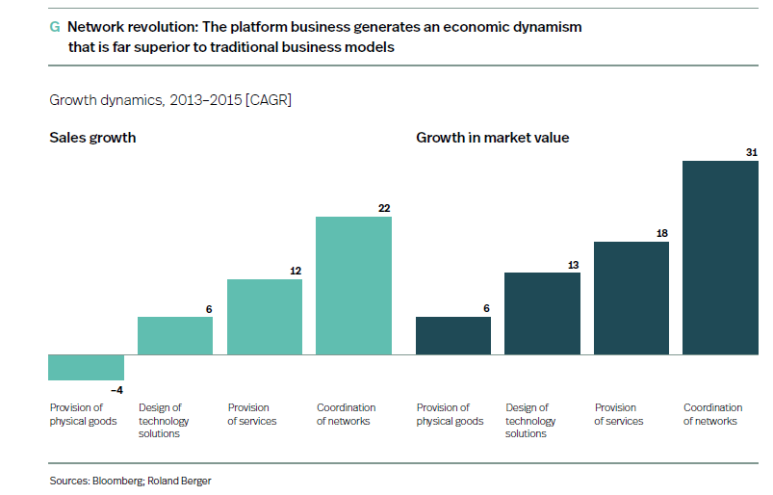 Market dynamics have changed dramatically in the past few years. The concept of connected networks has been having an increasing impact on all industries and market sectors.
Market dynamics have changed dramatically in the past few years. The concept of connected networks has been having an increasing impact on all industries and market sectors.
Specifically, the platform business model has been generating a significant dynamism that is hard to ignore recently. We are increasingly in need to scale as quickly as possible and by moving to the emphasis of platform capacity, helps this considerably.
Platforms require networks and the need to build ecosystems and the whole focus is on increasing engagement, or build this “capacity”. Connecting all this up can provide real scale. Building greater capacity, especially without adding to resources yields a greater return.
I feel the way we presently view scale, one presently linked far more to one single entity, one that is wanting to scale up their business model and that limits opportunities. I feel searching for new ‘capacity’ opens this up and takes us more towards the open, collaborative platform business model, where real growth seems to reside for our business futures.
The digital platform is fast becoming the most powerful driver of innovation.
The digital platform allows through this capacity building to seek out productivity and collaborations. A platform only works in the ability to engage and build activity and momentum. They increasingly lend themselves to searching for a more radical innovation design. They can deliver more tailored made solutions in new products and services that combine multiple parties expertise to deliver a greater complexity in new bundles and combinations that meet that increasing need to “cut across” previous stand-alone sectors.
We can see this “platform effect” in Uber, TripAdvisor, Airbnb that offer increased transparency, comparison and build new combined services, these new bundles and combinations that make customer engagement easier to complete a whole journey or holiday “package” through the connected platform providers and their ecosystem of partners.
Also we see platforms constantly collapsing down transaction costs due to this ability to compare and be more transparent, allowing for consumers to have more ‘informed’ choices. This has then forced more efficiencies out of the system. Supply chains have become more focused on productivity and focused activities. Specialised have become more focused on offering a clear expertise in a given service. The industrial platform (B2B) is catching up on its business-to-consumer (B2C) digital sibling.
Platforms are economic drivers
Platforms are achieving different levels of penetration than before, you have the connection in your hand, they give customer benefits in this connected world, delivered on the platform and in new ways of innovating products and services, that allow you to “tailor and build” your solutions to your specific needs. We achieve greater convenience, choice, assortment and pricing comparison.
Platforms have become aggregators of supply and demand, this two-sided platform solution where demand and supply need to have a clear focus on any business platform solution. They work on reducing frictions, increasing choices, adding greater flexibility of timing, choice and solution combinations.
Risks, transaction costs, information gathering, negotiation and communications all change within good business platform models to become more effective at managing the process or transaction.
Lastly, the capacity within platforms allows for a more dynamic growth with lower marginal additional costs.
Of course, platforms are based on technology, lots of it.
The more superior application and solution, the ability to exponentially grow demand become critical. The attraction of one platform over another is determined by the dynamics of the technology solutions. It is this focusing on technology solutions is where one platform provider scores over the other.
This is such a growing area of my focus. The application of digital solutions through technology, ones that are powering innovation and our economic growth.
I came across this visual from a Roland Berger report on the state of platforms in Europe. It states a platform business is far superior to many of today’s traditional business models focused on “just” physical goods. If you are searching for growth today it has to be based on the Network Revolution, as they nicely put it. Just look at this:

Understand and work out how the new market dynamics will grow your business and that is digitally
If you are not designing technology solutions, focusing on increasing your provision of services or working within coordinated networks no wonder your business is stagnant or declining, if not today then certainly real soon.
Innovation has such a high component of digital in the final solutions we are offering. Today our knowledge feeds innovation, digital feeds our knowledge, in our access to it and making the connected understanding as part of our solution designs.
All I can urge you to do is get into platform understanding, which works for you, which offers the greater potential, which allows you to connect up and build greater innovative offerings by recognizing working alone is the path to oblivion.
It is through collaboration and digital solutions you have a chance to redesign your business and make the connections with the consumer or your customers, who are all increasingly raising their expectations, wanting solutions that are fitting their lifestyle or business needs, so they can extract more and that is through digitally connected solutions.